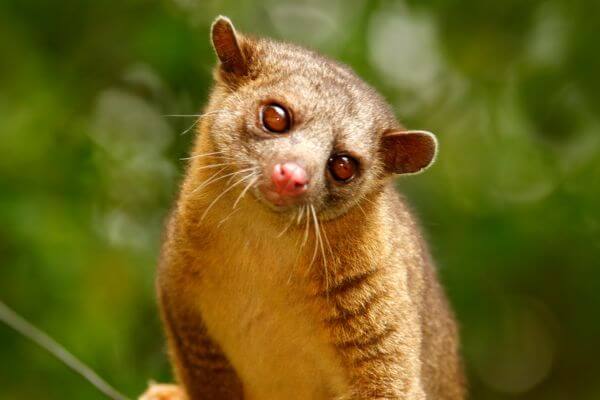The kinkajou, also known as the Jupará, is an adorable nocturnal mammal, hiding a series of surprises in its nocturnal life. The kinkajou is mostly found in tropical regions of Central and South America, including countries such as Mexico, Belize, Costa Rica, Panama, Colombia, Ecuador, Peru and Brazil.
In this article, we delve into its fascinating world to unlock its best kept secrets. From their keen night vision to their impressive acrobatic skills, passing through their eating habits and ways of communicating.
Their lifestyle is adapted to darkness. Through this exploration, we discover this master of the night’s survival strategies and witness the magical dance the kinkajou performs in the dark, revealing the true essence of its existence.
Keen Night Vision: The Magic Behind the Kinkajou’s Eyes
This small mammal has an impressive visual adaptation, allowing it to see clearly in the dark of night. Your eyes are true wonders of nature, capable of capturing even the smallest details in low-light conditions. This keen night vision plays a crucial role in their survival.
During the night, when most animals struggle to see, the Jupará stands out as a master of darkness. Its visual ability allows it to locate prey, identify obstacles and avoid predators with impressive dexterity. This hidden magic in their eyes is an example of how nature has developed amazing adaptations to ensure the survival and success of this lovely nocturnal mammal.
The Art of Night Locomotion
The kinkajou reveals a true display of acrobatic skills, demonstrating surprising dexterity and agility in its journeys through the trees. With its remarkable adaptation to life in the heights, it uses its sharp claws and strong limbs to scale logs and branches with ease. Her movements are fluid and graceful, seeming to defy gravity with every leap. Its impressive leaps give it a unique advantage in foraging for food and avoiding predators.
This acrobatic ability turns him into a true tree magician. It navigates through the branches with grace and confidence, exploring its nocturnal environment with fearlessness. The art of nocturnal locomotion of the Jupará reveals the wonderful adaptation of this species to its habitat, allowing it to survive and thrive amidst the complexities of the forest canopy.

Nocturnal Eating Habits: The Flavors of the Night for the kinkajou
This mammal is skilled at adapting to the resources available in the nocturnal environment to obtain its necessary nutrition and energy. During the night, the Jupará seeks a variety of flavors to satisfy its hunger. He feasts on ripe fruit, which can be found on trees during darkness, enjoying the sweet, juicy flavors of these foods. In addition, it is known for its ability to hunt nocturnal insects, such as moths and beetles, which provide an important source of protein for its diet.
Its ability to adapt to the resources available at night reflects its uncanny ability to find food even in challenging conditions. These nocturnal eating habits are a testament to their resilience and versatility, allowing them to enjoy unique flavors and ensure their survival in their nocturnal habitat.
Communication in the Dark: The Mysterious Vocalizations
The kinkajou uses a variety of sounds and vocalizations to communicate with other members of its species, transmitting messages and establishing social bonds amidst the darkness. Their vocalizations are captivating and mysterious. During the night, these sounds echo through the forest, creating a natural symphony of social interactions and territoriality.
Vocalizers can range from soft, melodic calls to more intense grunts, each with its own specific purpose. These vocalizations play a key role in communication between individuals, allowing them to transmit information about location, emotional state and even alert about the presence of dangers in the area.
Communication in the dark is essential to the kinkajou’s survival and social cohesion. Their mysterious vocalizations are a reflection of the complexity and richness of social interactions among these nocturnal animals. By exploring and better understanding their vocalizations, we are invited to unveil the secrets of their peculiar language and appreciate the importance of communication in this nocturnal environment.
Nocturnal Relations: The Social Gatherings of the Kinkajou
These adorable mammals have an active social life, interacting and bonding with other members of their species during the darkest hours. During their nocturnal encounters, the Jupará demonstrate complex social behaviors. They gather in social groups called flocks, where they can share spaces and resources.
These meetings are important for group cohesion, joint search for food and mutual protection against predators. In addition, they also communicate through visual signals, sounds and subtle touches, strengthening social ties and establishing hierarchies within the flock. These nocturnal relationships are essential for the survival and well-being of the Jupará, demonstrating the social and affective aspect of this charming species.
Night Survival: The Challenges and Strategies
To face obstacles and guarantee its survival in this dark environment, the Jupará has developed impressive adaptive strategies. One of the main challenges faced is the search for food in the dark. To overcome this difficulty, the kinkajou uses some strategies:
- It uses its keen night vision and agile tree-driving abilities to locate ripe fruit, insects, and other food resources available during the night.
- The kinkajou can also adapt to different food sources, adjusting its diet according to seasonal availability and resource location.
- Another challenge faced by the Jupará is the threat of nocturnal predators. To avoid detection and capture, it relies on its ability to blend in with trees and remain inconspicuous during its nocturnal activities.
- In addition, they can use their vocalizations to alert other members of the group about the presence of predators, reinforcing collective protection.
The kinkajou’s strategies and skills in night survival demonstrate its incredible ability to adapt to the challenges posed by darkness. These charming animals are true masters of the nocturnal life. The Jupará captivates us with its ability to adapt and thrive in the dark of night. Its remarkable traits, such as keen night vision, acrobatic movements, food preferences and ways of communicating, reveal an incredibly versatile and resilient species.
As we explore the enchanting world of the kinkajou, we are reminded of the complexity and diversity of wildlife, and the amazing ability of living things to adapt to the challenges of their habitat. The kinkajou and its nocturnal dance are an inspiring reminder of the beauty and magic that nature offers us, even when the lights go out.

